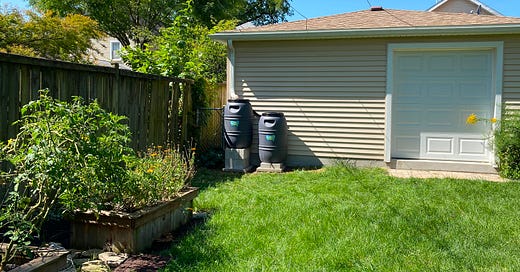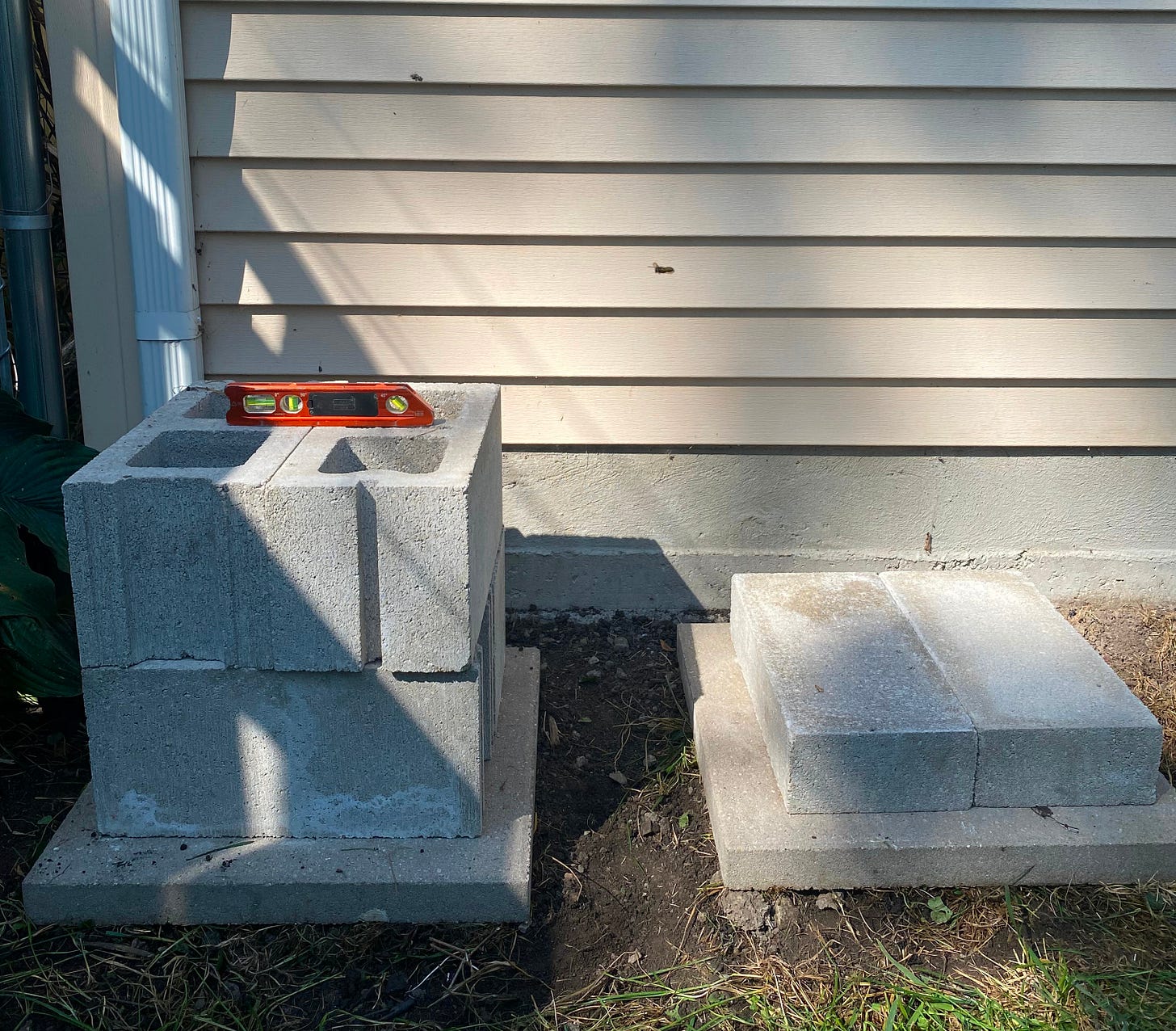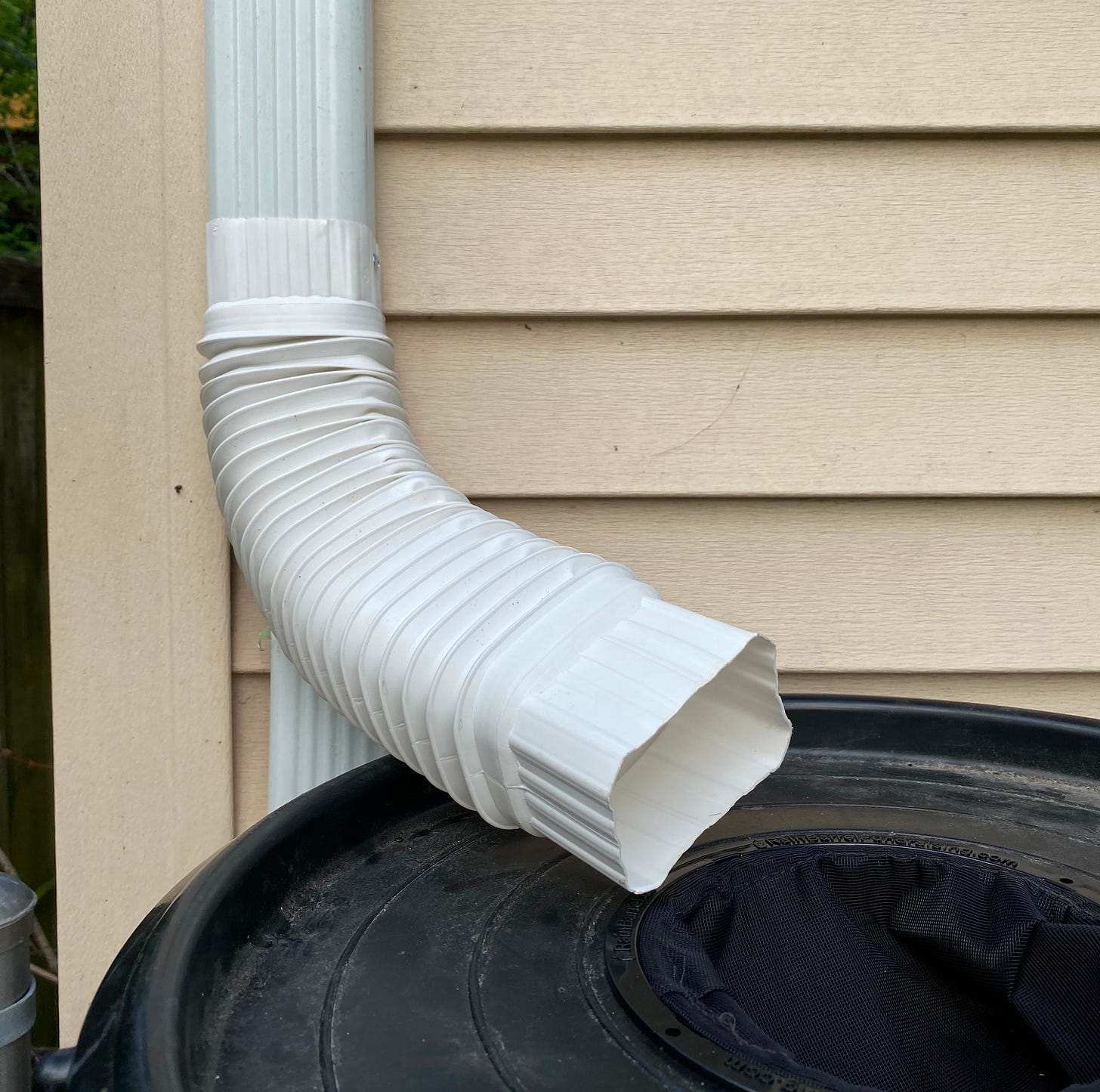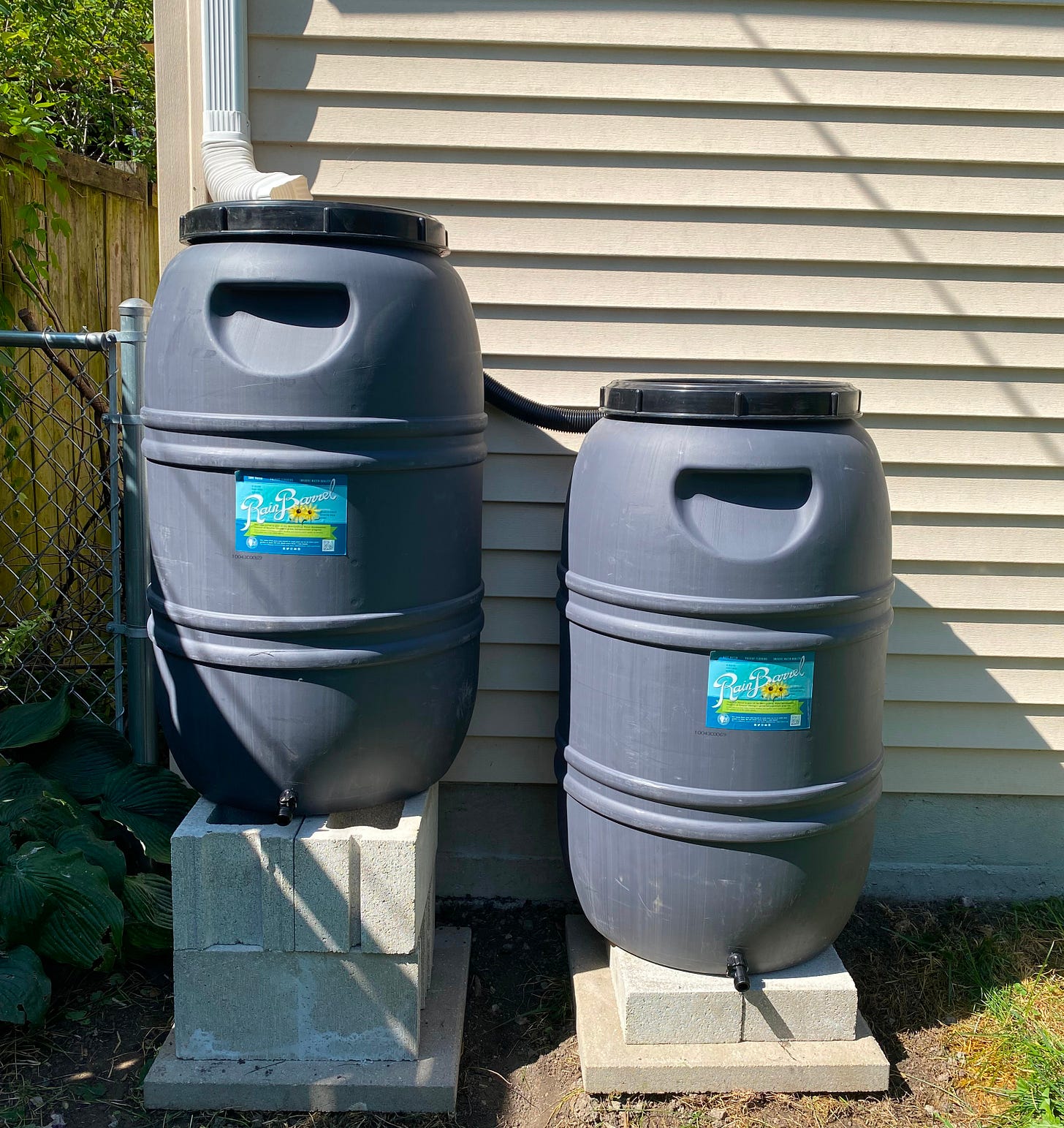Redesigning suburbia: the rainy day edition!
Okay, I might have a new ongoing series of articles about suburban landscape design and how it’s the absolute worst. Many typical landscaping practices like extensive lawn care, planting exotic plants, and fall leaf management (this one really makes my blood boil - I’ll have an piece on it soon!) are labor intensive, emissions intensive (e.g. one hour of using a commercial leaf blower is the emissions equivalent of driving a car 1100 miles), wasteful, biodiversity-annihilating, and just ecologically asinine.
You might see some little brown birds and a few bugs flying around your yard, and not think much of it. But suburban landscapes are often practically wastelands. All this stuff that we do to achieve the painfully banal aesthetics of suburbia creates landscapes that are ecologically useless, brittle, and not resilient. I think it also does that to our brains, actually.
I could go on and on.
And I will!
I really strongly believe that suburban communities could be ecologically resilient sites of incredible biodiversity, plus places of robust networks of community care and mutual aid (I wrote about one amazing way my community has done this). Basically, suburbia could be a super awesome model of how to live collectively and sustainably in dense(ish) communities, if we stopped doing all the dumb, individualistic shit we do in suburbia merely because it’s a cultural or aesthetic norm.
Anywho!
In this piece, I’m going to focus on rainwater management. The big climate change issue where I live is flooding. We’re getting more and more freakishly heavy rainstorms, punctuated with periods of drought. When the ground is dry, it doesn’t absorb water as well (think of a sponge - a wet sponge absorbs better than a dry one), so if you get a heavy rainstorm after a drought, you’ll have lots of runoff and sewers will be overwhelmed. You can, of course, also have the opposite problem. If the ground is too saturated with not enough ways to absorb excess water, you’ll also have lots of runoff.
And you know what’s really bad at absorbing water? Grass! Turf grass has very shallow roots, so can’t uptake much water. Another reason lawns are crappy for anything other than playing soccer or pretending like you’re a member of the British aristocracy in the 18th century, and who the hell would want to do that? Aristocrats are jerks! (Lawns originated as a kind of status symbol of the European nobility because of how much work they took to maintain - only nobles had the wealth to employ enough laborers to do it for them. I mean, gross. Why do we still emulate this centuries later?)
Many native plants are excellent at absorbing water, as they tend to have very deep roots. That said, I’ll get into rain gardens in another post.
This one is about… rain barrels! A great way to mitigate flooding and capture water for reuse.
I’ve studied some permaculture (I won’t get into why it’s both great, and also problematic. Consult Poor Proles Almanac if you want brilliant analyses of all that) and one objective of permaculture is to retain as much rainwater as possible on your landscape through strategies like rain barrels, cisterns, and swales, so it can be used by the plants, animals, and people there.
I finally installed the rain barrels this week. I chose to install two, so when the first is full, overflow can go into the second one.
I ordered ours from the Metropolitan Water Reclamation District’s rain barrel program for Cook County residents. It took them about four weeks to be delivered. If you don’t live in Cook County, you may want to check your local sewerage/water reclamation district for similar programs. Otherwise, just use the Googles.
MWRD’s barrels come with a spigot, overflow connector hose, and mosquito screen (crucial!). It also said it comes with a flexible downspout elbow, but what it actually came with was a large, black, flexible plastic tube, which could’ve worked, probably, but isn’t really a downspout elbow, so I just got one because they’re only a few bucks.
Here’s the rest of my supply list:
2 large concrete pavers
4 cinder blocks
2 concrete bricks
Flexible downspout elbow (note, there are different sizes, which I didn’t know. Standard residential downspouts are either 2x3 or 3x4. My downspout is 2x3)
Hacksaw and tin snips
Sheet screws
Screwdriver
Tape measure
Level
Pencil
Gloves
I put my rain barrels behind our garage. It would’ve been nice to find a spot by our house since it could maybe help prevent seepage in our basement, but there weren’t really any unobstructed locations under a downspout. Plus, I have raised beds in the backyard where I grow veg, so that’s what gets watered the most. So it makes sense to have the rain barrels there.
So, the first thing I had to do was level the ground under the downspout, where the barrels were going.
I almost half-assed this and just eyeballed it (I’m not gonna lie, I half-ass a lot of stuff like this. Good enough is almost always good enough for me). But then I decided to do it right and got the level to check a few times with the pavers down, the cinder blocks, and finally, with the barrels on top. If you’re doing two rain barrels, you’ll want the overflow barrel to be slightly lower in height than the primary barrel so the water can flow easily between the two. So I put four cinder blocks and a paver under the primary barrel, and two concrete bricks and a paver under the overflow barrel.
Once the foundation was ready, I attached the spigots and overflow valves to the barrels and positioned everything so I could see how it all fit. The overflow hose provided to connect the two barrels was a little long, so I used my tin snips to cut it down to size.
Then came the fun part: cutting my downspout! I lined up the flexible elbow with the downspout on my garage, so that the end of the elbow was pointing right into the top of the rain barrel. You want to slide the elbow over the downspout so there’s a couple inches overlapping, so I used a pencil to mark a bottom line on the downspout where I was going to cut, and a top line, about two inches above that, where the top of the elbow would be positioned.
Here’s what I mean:
Then I used a hacksaw to cut into the bottom line of the aluminum downspout. It was kind of a pain and made some awful racket with metal scraping on metal. I think I might have kind of a shitty hacksaw, too. I don’t know. Anyway, once I cut through enough of the downspout with the hacksaw, I switched to tin snips to finish the job. They didn’t make as much noise and I was less likely to accidentally damage the siding on my garage. Also, pro tip - wear gloves when you’re doing this. Maybe I’m just bad at cutting aluminum (I mean, I’m sure I’m bad at it, I’ve never done it before), but it was real jagged and could easily cut you.
Once you’re done cutting the downspout, keep the bottom part. You’ll want to reattach it in the winter when you weatherize the rain barrels.
Then I slid the elbow on and used sheet screws to secure it.
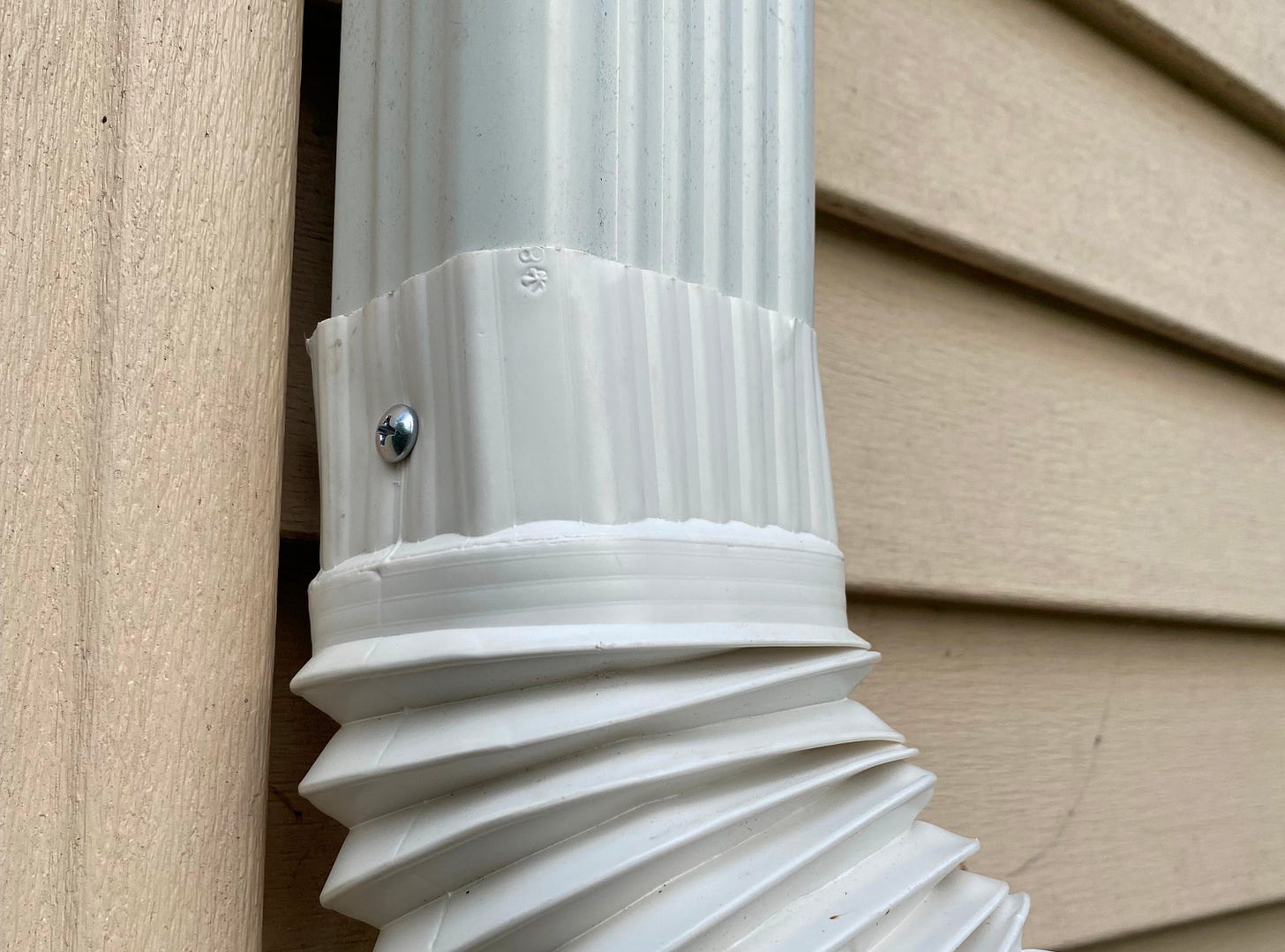
Then, I put the barrels in place, attached the overflow hose between the two, and made sure both spigot valves were shut so rainwater wouldn’t leak out.
And done!
As a one person job, it took me about 2.5 hours, and a good chunk of that was just leveling the rocky, dry ground.
So now I have rain barrels! Just in time for virtually no chance of rain for the next 10 days! And I’ll probably need to weatherize them in a mere six weeks! But hey, I’m just glad I actually finished a project.
I did not watch the debate because I just full-on absolutely hate electoral politics at this point and think it’s an enormous waste of my time and energy and attention. But I was told by a friend that Trump said “we have a president who doesn’t even know if he’s alive.” And even though Trump is obviously a clod, that’s hilarious.


